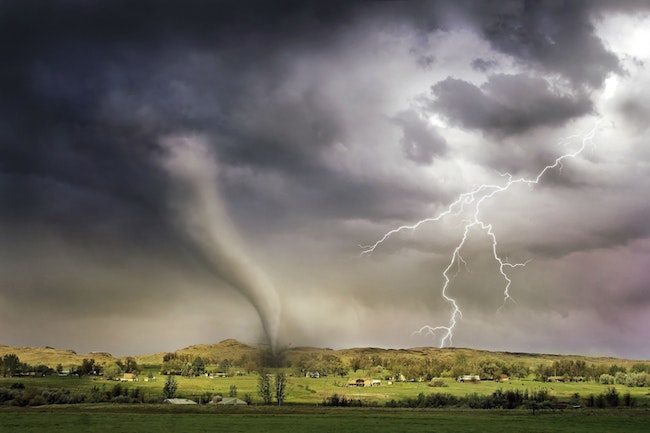As tornado season approaches, you might hear the terms “storm shelter” and “safe room” advertised as areas to take shelter during a storm. But what do these terms really mean when it comes to storm safety? What kind of protection are they designed to provide?
It's important to understand that these terms cannot be thrown around lightly. A structure or area of a building can only officially be identified as a “storm shelter” or “safe room” if it has been specifically engineered and constructed to meet its respective design requirements related to extreme wind events.
“Storm shelter” refers to a structure designed per the ICC/NSSA Standard for the Design and Construction of Storm Shelters (ICC 500-2020). This is the governing standard that is referenced by codes such as the International Building Code (IBC) and establishes “minimum requirements to safeguard the public health, safety, and general welfare relative to the design, construction and installation of storm shelters.”
“Safe room” specifically applies to structures meeting FEMA P-361 (community and residential) or FEMA P-320 (residential with design plans) criteria. The first edition of FEMA P-361 is actually the original design and construction guide for hazard-resistant buildings, and ICC 500 became the codified version of FEMA’s info and recommendations. The FEMA documents now reference ICC-500, but still contain a few stricter requirements and additional guidelines or “best practices” for design and operation. FEMA safe rooms are intended to provide “near-absolute protection.”
Based on these definitions, all safe rooms can be considered storm shelters, but not all storm shelters can be considered safe rooms. However, both are designed with the intent to provide life safety during extreme wind events.
Although ICC 500 and FEMA requirements encompass everything from mechanical, electrical, and plumbing to fire safety and means of egress, the fundamental purpose of a storm shelter or safe room is to protect occupants from injury or death due to extreme wind pressures and airborne debris impact that might occur during a natural disaster. That means there are some unique structural design loads and considerations that have to be taken into account.
Here’s a quick overview of a few types of ICC-500 and FEMA structural design loads for storm shelters and safe rooms:
Design Wind Speed:
All structures are required by code to be designed to resist lateral and uplift pressures caused by wind. But a storm shelter or safe room that’s meant to provide life safety during a major tornado is designed for a higher wind speed (and consequently, higher loads) than a typical building ‒ the question is, how much higher?
Per the current ASCE 7-16, the design wind speed for an everyday building in the Midwest (i.e. a non-hurricane zone) ranges from 105-115 mph. Conversely, ICC 500 requires that a tornado storm shelter in this area have a design wind speed of 250 mph.
Still, not every storm shelter needs to be designed for the maximum 250 mph. ICC-500 design wind speeds actually vary depending on location-based risk factors and whether the structure is intended to be a tornado shelter or a hurricane shelter.
Stricter FEMA criteria kicks in for residential storm shelters. In order for a residential shelter to be considered a FEMA safe room, it has to be designed for the worst-case 250 mph wind, regardless of storm type or location. According to FEMA, designing a small residential storm shelter for worst-case conditions doesn’t have a huge impact on cost, whereas the cost difference between designing a large community shelter for 250 mph vs. a lower wind speed could be significant.
Wind-borne Debris Impact:
Ever heard of the “15 lb 2x4 at 100 mph” test?
Texas Tech University is credited with developing the infamous missile impact test. Observations from post-storm damage assessments indicated that this type of windborne projectile most closely simulates debris that can penetrate building envelopes. Structural assemblies (walls and roofs) and “impact-protective systems” (assemblies or devices protecting openings in the storm shelter envelope) are required to have passed pneumatic cannon missile impact testing per ICC 500 Section 803 and ASTM E1886.
Similar to design wind speeds, test requirements for 2x4 weight and speed vary depending on anticipated severity (vertical vs. horizontal surface, tornado vs. hurricane, high risk vs. low risk location). Also, FEMA again requires that residential safe rooms meet the most severe criteria.
Laydown and Falling Debris Hazard:
Another concern for storm shelters is impact from falling objects caused by high winds. Laydown hazards include tall trees, poles, self-supporting towers, or exterior walls of adjacent single story structures that could fall on the roof of the storm shelter. Falling debris consists of cladding or roof top equipment that could blow off of adjacent, taller structures. Per ICC 500, storm shelters within a specified laydown or fall radius have to be designed for impact, or two times the estimated weight of the laydown or falling debris hazard.
Roof Live Load:
Live loads refer to non-natural, transient gravity loads a structure might see. A typical roof is designed for 20 psf live load (although the design load may be lower or higher based on use and ASCE 7-16 requirements). ICC 500 requires a much higher roof live load: no less than 100 psf for a tornado shelter and 50 psf for a hurricane shelter.
This list is intended to give a general overview of some of the structural design considerations for storm shelters and safe rooms as required by ICC 500 and FEMA and is by no means a comprehensive guide. The design of these structures should be handled by design professionals who deal with the ICC 500 on a regular basis and know the ins and outs.
A regular building is not designed with the intent to protect occupants from injury or death during an extreme event such as a tornado ‒ storm shelters and safe rooms are. Hopefully, you now have a general understanding of some of the heightened structural provisions that factor into design, allowing storm shelters and safe rooms to provide life-safety protection during a storm.



There are no comments.